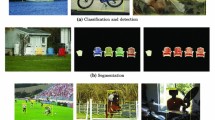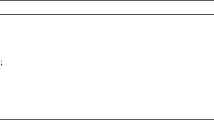Abstract
Block principle component analysis (BPCA) is a recently developed technique in computer vision and pattern classification. In this paper, we propose a robust and sparse BPCA with Lp-norm, referred to as BPCALp-S, which inherits the robustness of BPCA-L1 due to the employment of adjustable Lp-norm. In order to perform a sparse modelling, the elastic net is integrated into the objective function. An iterative algorithm which extracts feature vectors one by one greedily is elaborately designed. The monotonicity of the proposed iterative procedure is theoretically guaranteed. Experiments of image classification and reconstruction on several benchmark sets show the effectiveness of the proposed approach.
Similar content being viewed by others
References
JOLLIFFE I T. Principal component analysis [M]. New York, USA: Springer, 2002.
YANG J, ZHANG D, FRANGI A F, et al. Twodimensional PCA: A new approach to appearancebased face representation and recognition [J]. IEEE Transaction on Pattern Analysis and Machine Intelligence, 2004, 26(1): 131–137.
KE Q F, KANADE T. Robust L1-norm factorization in the presence of outliers and missing data by alternative convex programming [C]//Proceedings of the 2005 Computer Society Conference on Computer Vision and Pattern Recognition. San Diego, USA: IEEE, 2005: 739–746.
DING C, ZHOU D, HE X F, et al. R1-PCA: Rotational invariant L1-norm principal component analysis for robust subspace factorization [C]//Proceedings of the 23rd International Conference on Machine Learning. Pittsburgh, USA: ACM, 2006: 281–288.
KWAK N. Principal component analysis based on L1-norm maximization [J]. IEEE Transaction on Pattern Analysis and Machine Intelligence, 2008, 30(9): 1672–1680.
NIE F P, HUANG H, DING C, et al. Robust principal component analysis with non-greedy L1-norm maximization [C]//Proceedings of the Twenty-Second International Joint Conference on Artificial Intelligence. Barcelona, Spain: [s.n.], 2011: 1433–1438.
LI X L, PANG YW, YUAN Y. L1-norm-based 2DPCA [J]. IEEE Transactions on Systems, Man, and Cybernetics Part B: Cybernetics, 2009, 40(4): 1170–1175.
WANG R, NIE F P, YANG X J, et al. Robust 2DPCA with non-greedy L1-norm maximization for image analysis [J]. IEEE Transactions on Cybernetics, 2015, 45(5): 1108–1112.
KWAK N. Principal component analysis by Lp-norm maximization [J]. IEEE Transactions on Cybernetics, 2014, 44(5): 594–609.
GAO Q X. Is two-dimensional PCA equivalent to a special case of modular PCA? [J]. Pattern Recognition Letters, 2007, 28(10): 1250–1251.
KONG H, WANG L, TEOH E K, et al. Generalized 2D principal component analysis for face image representation and recognition [J]. Neural Networks, 2005, 18(5/6): 585–594.
WANG LW, WANG X, ZHANG X R, et al. The equivalence of two-dimensional PCA to line-based PCA [J]. Pattern Recognition Letters, 2005, 26(1): 57–60.
GOTTUMUKKAL R, ASARI V K. An improved face recognition technique based on modular PCA approach [J]. Pattern Recognition Letters, 2004, 25(4): 429–436.
KIM C, CHOI C H. Image covariance-based subspace method for face recognition [J]. Pattern Recognition, 2007, 40(5): 1592–1604.
WANG H X. Block principal component analysis with L1-norm for image analysis [J]. Pattern Recognition Letters, 2012, 33(5): 537–542.
WANG H X, WANG J. 2DPCA with L1-norm for simultaneously robust and sparse modelling [J]. Neural Networks, 2013, 46: 190–198.
WANG J. Generalized 2-D principal component analysis by Lp-norm for image analysis [J]. IEEE Transactions on Cybernetics, 2015, 46(3): 792–803.
JENATTON R, OBOZINSKI G, BACH F. Structured sparse principal component analysis [C]//Proceedings of the 13th International Conference on Artificial Intelligence and Statistics. Chia Laguna Resort, Italy: [s.n.], 2010: 366–373.
Author information
Authors and Affiliations
Corresponding author
Additional information
Foundation item: the National Natural Science Foundation of China (No. 61572033), the Natural Science Foundation of Education Department of Anhui Province of China (No. KJ2015ZD08), and the Higher Education Promotion Plan of Anhui Province of China (No. TSKJ2015B14)
Rights and permissions
About this article
Cite this article
Tang, G., Lu, G. Block Principle Component Analysis with Lp-norm for Robust and Sparse Modelling. J. Shanghai Jiaotong Univ. (Sci.) 23, 398–403 (2018). https://doi.org/10.1007/s12204-018-1955-4
Received:
Published:
Issue Date:
DOI: https://doi.org/10.1007/s12204-018-1955-4




